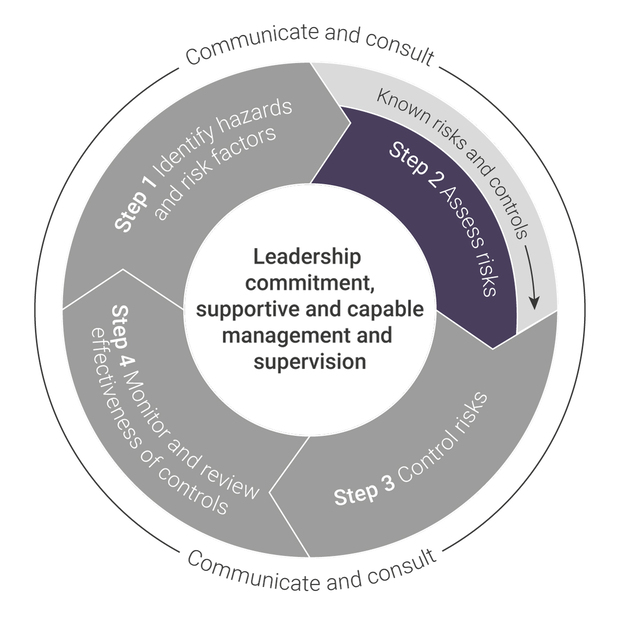On 31 March 2022, the Work Health and Safety (WHS) laws replaced the health and safety elements of the Mines Safety and Inspection laws. For information visit www.demirs.wa.gov.au/whs
All health and safety notifications, forms and guidance for mining and petroleum has moved to the WorkSafe website
The information below has been left for historical compliance reference purposes

Following the identification of psychosocial hazards and risk factors at the workplace, the next step in the risk management process is assessing the risks of harm, which follows the same principles as the risk assessment undertaken for other hazards.
A risk assessment helps determine:
- who might be exposed
- the source of the risks
- how severe the risks are — the frequency and duration of potential exposure to a psychosocial hazard, possible consequences of exposure and likelihood of harm
- whether existing controls are effective
- what additional measures should be implemented to control the risks
- how urgently action needs to be taken.
It is important those undertaking the risk assessment have access to information about the work environment and work processes, and knowledge and understanding of potential psychosocial hazards and risk factors.
Assessments should:
- include data collection and monitoring of existing controls (e.g. hazard and incident reports, human resources data, workers’ compensation claims, de-identified surveys, focus group reports)
- involve consultation with the workforce, and safety and health representatives and committees
- cite the evidence used.
Note: The same risk management processes used for physical health and safety may be applied to mental health and wellbeing.
Resources
|
This tool by the Danish National Institute of Occupational Health may be used to assess the psychosocial work environment, as well as facilitating practical interventions at workplaces. Three versions of the questionnaire are available: a long version for research use, a medium-length version for use by work environment professionals, and a short version for workplaces. |
|
| Guarding Minds | Guarding Minds is a free online resource that helps employers assess psychological health and safety in their workplaces. Tools include an organisational review, employee questionnaire and comprehensive survey. |
| Health and Safety Executive (HSE) UK | HSE provides free online guidance and tools to help small businesses assess and control risks in the workplace. Resources include example risk assessments and risk assessment and policy templates. |
|
Developed by Safe Work Australia, the University of Queensland, the Australian National University, Queensland Government and WorkSafe Victoria, People at Work is a free psychosocial risk assessment tool to help organisations implement a psychosocial risk management approach and evaluate the effectiveness of chosen interventions. |
|
|
The Stress Indicator Tool by the UK Health and Safety Executive (HSE) measures the attitudes and perceptions of an organisation’s employees towards work-related stress. Complementing HSE's management standards for stress approach, it comprises a survey of thirty-five questions asking about six key areas of work that, if not managed properly, are known to be potential causes of workplace stress. The tool provides a quick and easy way to determine the extent to which work-related stress is a problem in an organisation, and the likely root causes. There is also guidance on managing work-related stress as part of a prevention culture. |

